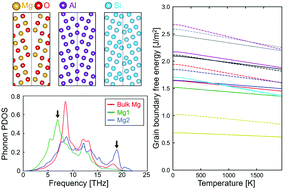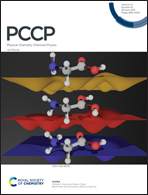An origin of excess vibrational entropies at grain boundaries in Al, Si and MgO: a first-principles analysis with lattice dynamics†
Abstract
First-principles lattice dynamics is applied to symmetric tilt grain boundaries (GBs) in Al, Si and MgO, with the goal of revealing critical factors in determining excess vibrational entropies at the atomic level. Excess vibrational entropies at GBs are found to vary depending on the substances. Al GBs tend to show larger excess entropies and hence larger temperature dependence of the GB free energies than those in Si and MgO. Most of the Si GBs show small excess entropies. For Al and MgO, atom-projected vibrational entropies are well correlated with bond-length changes at GB cores, and have large positive values as bond lengths increase for GB atoms. This demonstrates that a similar mechanism likely dominates excess vibrational entropies of GBs for both substances, despite their dissimilar bonding nature. For Si GBs, atoms with threefold coordination do not simply follow such a correlation, implying the importance of other factors that are different from bond-length changes. These systematic comparisons will be a foothold for understanding a physical origin of excess entropies at GBs even in more complex substances.



 Please wait while we load your content...
Please wait while we load your content...